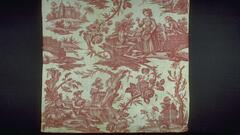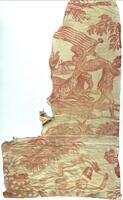Copperlate Textile Printing
Explore politics, technology, art, and culture through 18th century cloth printing
Cotton cloth production and printing developed in India and was brought to the Europe through early explorers and colonizers. Indian cotton woodblock print cloth’s increasing popularity led to a ban on its import in England to protect the countries wool industry. In the mid eighteenth century England lifted the import ban leading to a flurry of new printing techniques and a race to develop efficient mass production print. Copperplate printing came into fashion in the 1750s developed by Francis Nixon and Theophlius Thompson in Dramcondra, Ireland. The technique quickly spread to London before J.P. Oberkampf took the technique to France creating the distinctive and prolific Rococo style typical of “Toiles de Jouy” prints. Copperplate prints were created through etching thirty-six by thirty-six copper squares then running the cloth and plate through a press to transfer the image. Due to the level of detail and minimal color pallet, copperplate printed cloth typically depicted scenic or narrative designs. Copperplate production allowed for more detailed and larger scale printing but monochromatic made it ideal for bed furnishing and drapes. Since the cloth was printed through copper etching compared to woven or wood block printing, designs were quickly mass produced making cloth a vehicle for political messages as well as fashionable designs.
4 Items in this Learning Collection
Resource with 16 media
Resource with 2 media
Resource with 1 media
Resource with 1 media
Created For
K-12 EducatorK-12 Student
Museum Visitor
UMMA Docent
UMMA Staff
University Faculty
University Student
Rate this Learning Collection
AVG: 0 | Ratings: 0
& Author Notes
Creative Commons by-nc-ndLast Updated
July 12, 2018 12:47 p.m.Report
Reporting Policy




